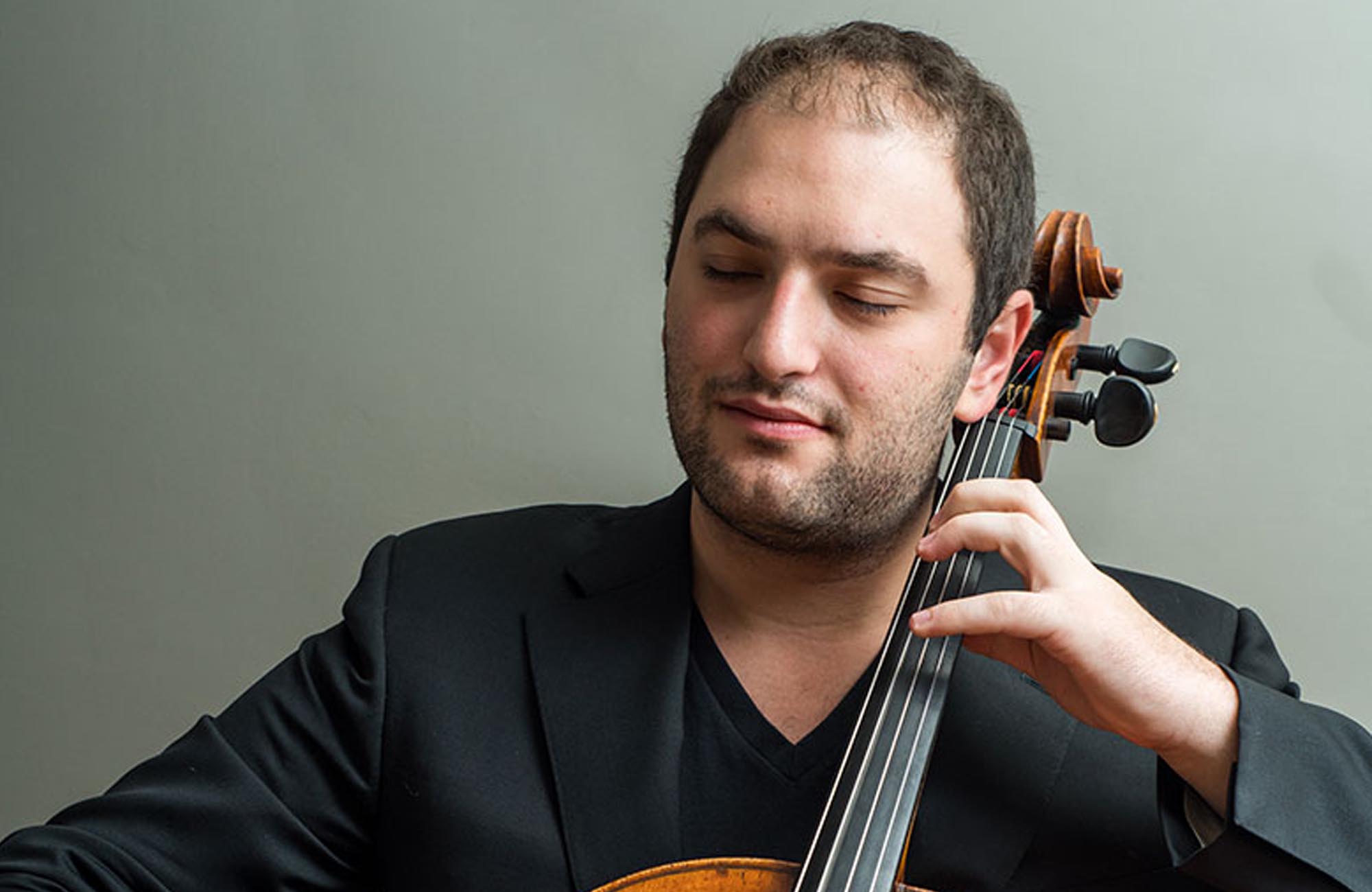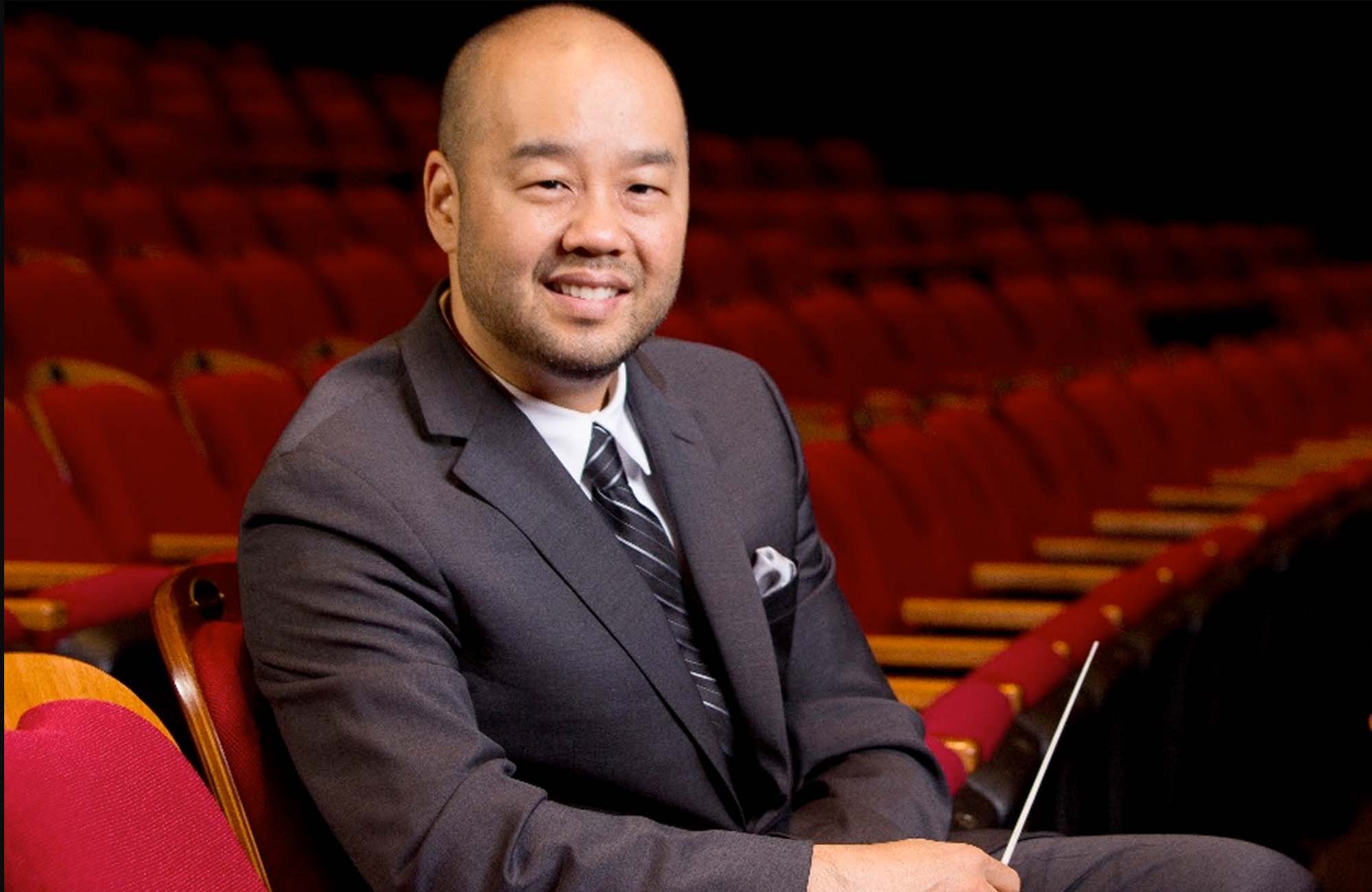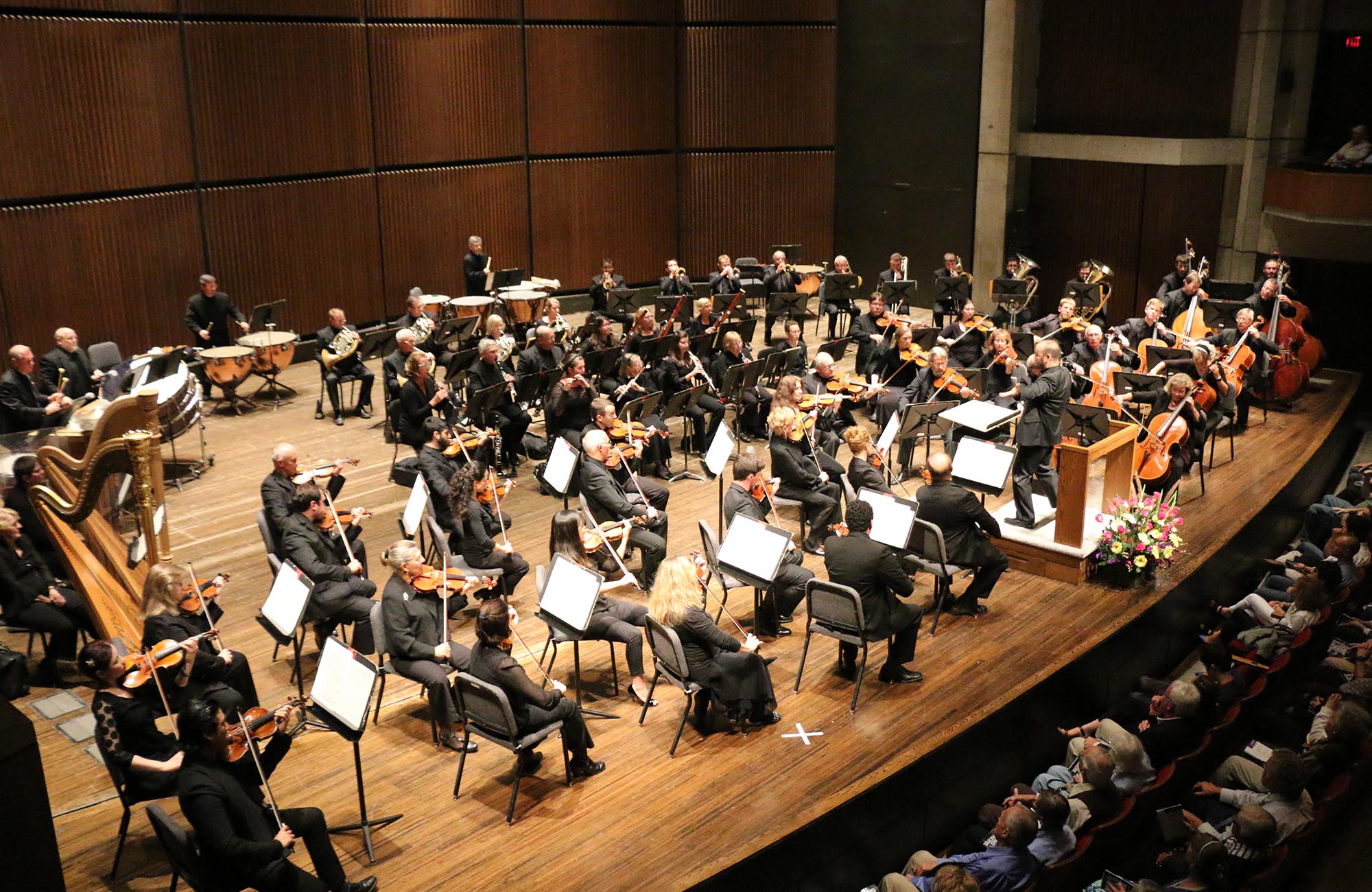PROGRAM
BUTTERWORTH: A Shropshire Lad; Rhapsody for Orchestra (1912)
Performed on November 5, 2018 at Crouse Hinds Concert Theater
Lawrence Loh conducting
ELGAR: Concerto for Violoncello, op.85, E minor
Performed on February 15, 2020 at Crouse Hinds Concert Theater
Lawrence Loh, conducting; Julian Schwarz, violin
NIELSEN: Symphony No.4, op.29 (The Inextinguishable)
Performed on November 5, 2018 at Crouse Hinds Concert Theater
Lawrence Loh conducting
PROGRAM NOTES
BUTTERWORTH: A Shropshire Lad
This evening’s concert opens with a tone poem by George Butterworth (1885–1916). Inspired, like much English music of the time, by the poetry of A. E. Housman, it’s a pastoral rhapsody with an overlay of both nostalgia and regret, perhaps stemming in part from what some commentators have claimed was Butterworth’s closeted homosexuality. Whatever its psycho- logical sources, though, this is one of the most poignant quarter-hours of British music you’ll hear, with a muted kinship to Wagner’s Tristan and Isolde and a timbral refinement that, via Butterworth’s friend ...
BUTTERWORTH: A Shropshire Lad
This evening’s concert opens with a tone poem by George Butterworth (1885–1916). Inspired, like much English music of the time, by the poetry of A. E. Housman, it’s a pastoral rhapsody with an overlay of both nostalgia and regret, perhaps stemming in part from what some commentators have claimed was Butterworth’s closeted homosexuality. Whatever its psycho- logical sources, though, this is one of the most poignant quarter-hours of British music you’ll hear, with a muted kinship to Wagner’s Tristan and Isolde and a timbral refinement that, via Butterworth’s friend Vaughan Williams, echoes the finesse of the French impressionists. And although A Shropshire Lad was composed before the war, it’s hard not to hear it as a premonition of the composer’s impending death, especially since the work ends with a forlorn flute, quasi lontano (as if from a distance), calling out a fragment of Butterworth’s song-setting of Housman’s “With rue my heart is laden // For golden friends I had.”
ELGAR: Cello Concerto
The Concerto for Cello and Orchestra composed in 1918-19 by Sir Edward Elgar (1857–1934). The regret is easy to understand. First, it was nourished by Elgar’s recognition of personal mortality: he had just gotten out of the hospital when he began it, and his beloved wife Alice was dying of lung cancer as he wrote it. Second, there was his growing realization that, having briefly been the standard-bearer for modern English music, his renown was fleeting—that in the wake of the radical works of Stravinsky, Schoenberg, and others, his Edwardian idiom was increasingly scorned as old-fashioned. Most important, the First World War had destroyed the Europe— indeed, the world—that he knew. Whether it was a conscious intention or not, the Cello Concerto turned out to be his farewell to composing; although he wrote a few snippets afterwards, this was his last substantial work.
Elgar was right that the Europe he knew was gone, but he was wrong about his own place in the musical pantheon. Fame operates in pendulum swings, and Elgar’s world-wide reputation is now, perhaps, even greater than at any point during his life. And in the century since its premiere (a disaster, like the first performances of so many masterpieces), the Cello Concerto has become a staple of the repertoire. It’s written in four movements (two sections of two movements each). And from the very opening—a plaintive recitative by the soloist with barely any orchestral support, followed by a theme introduced by the darkly tinted orchestral violas—it’s got, in conductor Larry Loh’s words, “what we love about Elgar, his ability to write heart-wrenchingly beautiful melodies.” As it follows its course, the concerto goes through a wide gamut of emotions (most profound in the third-movement Adagio); and it gives the soloist, especially in the rapid-fire second movement, plenty of room for virtuoso display. But even in the heroic affirmation of the final pages, ushered in by a return of that opening recitative, the nostalgia lingers in the air. In the aftermath, it’s easy to understand why it has come to be seen as perhaps the great 20th-century cello concerto.
NIELSEN: Symphony No. 4
Our closing work, the Symphony No. 4 (The Inextinguishable) (1914–16) by Carl Nielsen (1865–1931), could not be more different—rugged where Butterworth’s is supple, defiant where Butterworth’s is yielding, extreme where Butterworth’s is modest. Like A Shropshire Lad, the Nielsen Fourth may well have some personal history behind it—it was written at a difficult time in his marriage. But it’s more clearly reflective of the state of the world and of Nielsen’s belief—more stubborn than simply optimistic—in the ability of the human spirit to prevail. As he puts it in a preface to the score, the title “The Inextinguishable” reflects “in one word what the music alone is capable of expressing to the full: The elemental Will of Life.” And he expresses that elemental will with a harmonic language that, as conductor Larry Loh points out, is completely individual.
In four continuous and thematically linked movements, the Fourth does not take long to announce its fundamental spirit—and to announce two of its key structural underpinnings. It opens with a furious series of cries in the woodwinds, echoed by fortissimo timpani thwacks. A minute and a half later, though, the orchestra announces a contrasting theme, which begins with downward-moving thirds on the clarinets, marked espressivo. The timpani, as we come to discover, do not serve simply as a punctuation mark. They are a crucial part of the musical argument. After a deceptively simple pastoral intermezzo (almost Brahmsian in spirit, and largely scored for winds) and an intense “Poco Adagio” (dotted with what some hear as bird calls), the finale is marked by an epic battle between two sets of timpani, placed on opposite sides of the stage. They compete, largely in canon, for dominance with what Nielsen calls a “menacing character,” which they are asked to maintain to the very end. And that theme that first shows up in the clarinets turns reappears in many guises throughout the symphony, and caps the triumphant, if hard-won, E major conclusion.
FEATURED ARTISTS

Julian Schwarz has been heralded from a young age as a cellist destined to rank among the greatest of the 21st century, Julian’s powerful tone, effortless virtuosity, and extraordinarily large color palette are hallmarks of his style.
After making his concerto debut at the age of 11 ...
Julian Schwarz has been heralded from a young age as a cellist destined to rank among the greatest of the 21st century, Julian’s powerful tone, effortless virtuosity, and extraordinarily large color palette are hallmarks of his style.
After making his concerto debut at the age of 11 with the Seattle Symphony, he made his US touring debut with the Moscow Radio Symphony Orchestra in 2010. Since being awarded first prize at the inaugural Schoenfeld International String Competition in Hong Kong, he has led an active career as soloist, performing with the symphony orchestras of Annapolis, Arizona, Boise, Buffalo, Charlotte, Columbus, Delaware, Des Moines, Hartford, Jacksonville, Louisville, Memphis, Modesto, Omaha, Puerto Rico, Richmond, Rochester, San Antonio, San Jose, Sarasota, Syracuse, Toledo, Tucson, Virginia, West Virginia, Wichita, and Winston-Salem, among many others. Internationally, he made his Australian debut with the Queensland Symphony, his Mexican debuts with the Boca del Rio Philharmonic in Veracruz and the Mexico City Philharmonic with frequent collaborator Jorge Mester.
As a chamber musician, Mr. Schwarz performs extensively in recital with pianist Marika Bournaki. In 2016 Schwarz & Bournaki were awarded first prize at the inaugural Boulder International Chamber Music Competition’s “The Art of Duo”, and subsequently embarked on an extensive 10-recital tour of China in March 2017. Mr. Schwarz is a founding member of the New York based touring ensemble “Frisson” and was recently appointed the newest core member of the Olmos Ensemble in San Antonio, TX. He is a member of the Palladium Chamber Players (St Petersburg FL), the Alaria Ensemble (New York NY), and has given over 100 performances at Brooklyn’s Bargemusic. He has appeared at the Cape Cod Chamber Music Festival, Orcas Island Chamber Music Festival, Seattle Chamber Music Festival, Josef Gingold Chamber Music Festival, Verbier Festival, and the Salzburg Mozarteum. In addition, he runs programming for the Tuesday evening chamber music series at the Eastern Music Festival in Greensboro, NC.
Mr. Schwarz is deeply committed to the future of American music, and will present the world premiere of Jennifer Higdon’s first Cello Concertro with a large consortium of orchestras spring 2026. His championing the cello music of Arthur Foote will result in the first commercial recording of Foote’s Cello Concerto (1894) with the Buffalo Philharmonic, to be released on the Delos label. Past commissioning projects include concertos by Lowell Liebermann (recorded with the Annapolis Symphony for release in 2025), Richard Danielpour, and Samuel Jones (recorded with the All Star Orchestra for public television in 2012, subsequently released as a DVD on Naxos). Other premieres include recital works by Paul Frucht, Scott Ordway, Jonathan Cziner, Gavin Fraser, Alex Weiser, Ofer Ben-Amots, Michael Ippolito, chamber music by Adolphus Hailstork, Henri Lazarof, Jonathan Newman, Bright Sheng, and the US Premiere of Dobrinka Tabakova’s Cello Concerto. Of special note is Mr. Schwarz’s ongoing commitment to the music of Jewish experience, including projects with the YIVO Institute for Jewish Research (music of Joachim Stutschewsky and his circle), the Defiant Requiem Foundation (music of Holocaust composers and their influence) Central Synagogue (yearly feature on Jewish Broadcasting), the Milken Archive of American Jewish Music—for which he has recorded the complete cello/piano works of Ernest Bloch, and a new association with South Florida Public Broadcasting to raise awareness of the history of Jewish music.
A devoted teacher, Mr. Schwarz serves as Associate Professor of Cello and String Area Coordinator at Shenandoah Conservatory of Shenandoah University (Winchester, VA), and on the artist faculty of NYU’s Steinhardt School of Music. In the summer, he teaches and performs at the Eastern Music Festival and the Josef Gingold Festival. In 2023, he was one of the first cellists to record pedagogical tutorials for the online teaching platform Tonebase, including comprehensive examinations of the Elgar Concerto, Piatti Caprices, tone production, and vocal elements in cello playing. As a writer, he has contributed frequently to Strings Magazine’s Artist Blog, has written learner’s guides for The Violin Channel, and has edited a series of Ernest Bloch editions with written prefaces for Carl Fischer Publishing. Past faculty appointments include artist-in-residence at the Lunenburg Academy of Music Performance (Nova Scotia, Canada) and faculty teaching assistant to Joel Krosnick at The Juilliard School.
Born in Seattle, WA in 1991 to a multigenerational musical family, Mr. Schwarz studied at the Academy of Music Northwest and the Lakeside School. He continued to the Colburn School in Los Angeles under Ronald Leonard, and then moved to New York City to study with mentor Joel Krosnick at The Juilliard School (BM 14, MM 16). Other influential teachers include the late David Tonkonogui, the late Toby Saks, the late Lynn Harrell, Neal Cary, and chamber music mentors Andre Roy, Arnold Steinhardt, Jonathan Feldman, Toby Appel and Paul Coletti. Julian plays a Neapolitan cello made by Gennaro Gagliano in 1743 and American bows by Paul Martin Siefried. A Pirastro and Melos artist, he endorses and plays the “Perpetual” medium and edition sets of cello strings and Melos light rosin.
Julianschwarz.com

Described as bringing an “artisan storyteller’s sensitivity… shaping passages with clarity and power via beautifully sculpted dynamics… revealing orchestral character not seen or heard before” (Arts Knoxville) Lawrence Loh enjoys a dynamic career as a conductor of orchestras all over the world.
After an extensive two ...
Described as bringing an “artisan storyteller’s sensitivity… shaping passages with clarity and power via beautifully sculpted dynamics… revealing orchestral character not seen or heard before” (Arts Knoxville) Lawrence Loh enjoys a dynamic career as a conductor of orchestras all over the world.
After an extensive two year search, Lawrence Loh was recently named Music Director of the Waco Symphony Orchestra beginning in the Spring of 2024. Since 2015, he has served as Music Director of The Syracuse Orchestra (formerly called Symphoria), the successor to the Syracuse Symphony Orchestra. “The connection between the organization and its audience is one of the qualities that’s come to define Syracuse’s symphony as it wraps up its 10th season, a milestone that might have seemed impossible at the beginning,” (Syracuse.com) The Syracuse Orchestra and Lawrence Loh show that it is possible to create a “new, more sustainable artistic institution from the ground up.”
Appointed Assistant Conductor of the Pittsburgh Symphony in 2005, Mr Loh was quickly promoted to Associate and Resident Conductor within the first three years of working with the PSO. Always a favorite among Pittsburgh audiences, Loh returns frequently to his adopted city to conduct the PSO in a variety of concerts. Mr. Loh previously served as Music Director of the West Virginia Symphony Orchestra, Music Director of the Northeastern Pennsylvania Philharmonic, Artistic Director and Principal Conductor of the Syracuse Opera, Music Director of the Pittsburgh Youth Symphony Orchestra, Associate Conductor of the Dallas Symphony Orchestra, Associate Conductor of the Colorado Symphony Orchestra and Music Director of the Denver Young Artists Orchestra.
Mr. Loh’s recent guest conducting engagements include the San Francisco Symphony, Dallas Symphony, North Carolina Symphony, Baltimore Symphony, Sarasota Orchestra, Florida Orchestra, Pensacola Symphony, Atlanta Symphony, National Symphony, Detroit Symphony, San Diego Symphony, Seattle Symphony, National Symphony (D.C.), Utah Symphony, Rochester Philharmonic, Indianapolis Symphony, Calgary Philharmonic, Buffalo Philharmonic, Albany Symphony and the Cathedral Choral Society at the Washington National Cathedral. His summer appearances include the festivals of Grant Park, Boston University Tanglewood Institute, Tanglewood with the Boston Pops, Chautauqua, Sun Valley, Shippensburg, Bravo Vail Valley, the Kinhaven Music School and the Performing Arts Institute (PA).
As a self-described “Star Wars geek” and film music enthusiast, Loh has conducted numerous sold-out John Williams and film music tribute concerts. Part of his appeal is his ability to serve as both host and conductor. “It is his enthusiasm for Williams’ music and the films for which it was written that is Loh’s great strength in this program. A fan’s enthusiasm drives his performances in broad strokes and details and fills his speaking to the audience with irresistible appeal. He used no cue cards. One felt he could speak at filibuster length on Williams’ music.” (Pittsburgh Tribune)
Mr Loh has assisted John Williams on multiple occasions and has worked with a wide range of pops artists from Chris Botti and Ann Hampton Callaway to Jason Alexander and Idina Menzel. As one of the most requested conductors for conducting Films in Concert, Loh has led Black Panther, Star Wars (Episodes 4-6), Jaws, Nightmare Before Christmas, Jurassic Park, Casablanca, The Wizard of Oz and Singin’ in the Rain, among other film productions.
Lawrence Loh received his Artist Diploma in Orchestral Conducting from Yale, his Masters in Choral Conducting from Indiana University and his Bachelor of Arts from the University of Rochester. Lawrence Loh was born in southern California of Korean parentage and raised in Carlisle, Pennsylvania. He and his wife Jennifer have a son, Charlie, and a daughter, Hilary. Follow him on instagram @conductorlarryloh or Facebook at @lawrencelohconductor or visit his website, www.lawrenceloh.com


